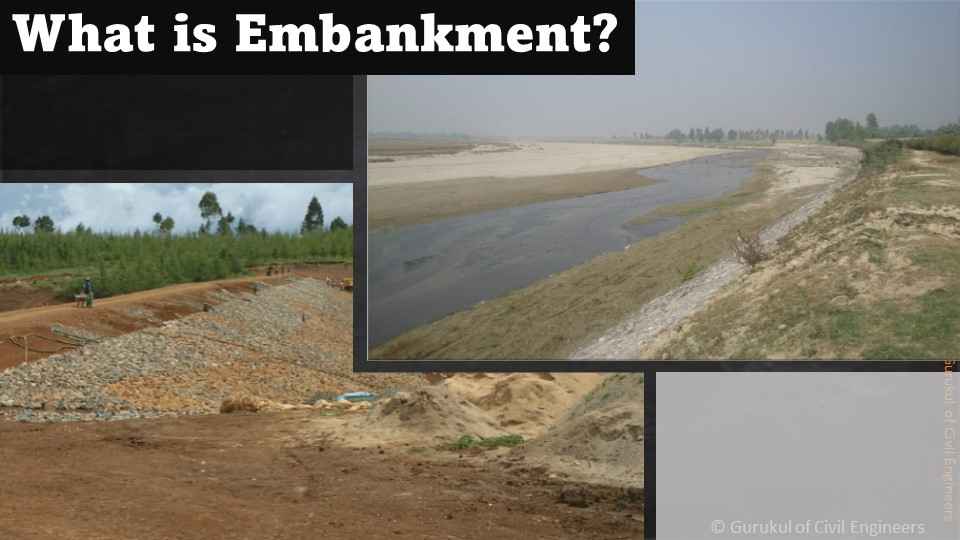What is the Purpose of Embankment?
- By
- Pooja |
- July 02, 2022 |
- Civil Engineering, Highway Engineering, Pway / Railways,

Table of Contents
Embankment to Restraint High Flood Water
Attributes of Embankment Materials
Unit Weight and Specific Gravity
What is an Embankment?
Earthen materials such as stone and soil are used to build an embankment to raise roadways or railways above the surrounding ground level in order to provide structural support. When building a dam, the most impermeable materials such as dirt, sand, or rock are used to make the core, while more permeable materials are used on the downstream and upstream edges to improve water flow.
Embankment
-
“Free lodging and a 25-year flood-return period are mandated by BIS (1.5m).
-
From the central river line, the embankment's orientation shall be determined at 1.5 times Lacey's width.
-
Slope protection requires pitching over the gabion design.
-
For the embankment, a side slope of 2:1 for embankments up to 5 meters high and 5 meters in width, including landscaping.
-
For vehicle crossings of 50m length and 10m breadth, the embankment needs to be widened every 1.00 km.
-
The embankment is surrounded by 50 cm of delicious soil on both on sides and top.
Embankment to Restraint High Flood Water
Attributes of Embankment Materials
1. Fine-Grained Soil
Any potential pathways of filtration through the zone or concrete structures must be eliminated before any material can be used.
For the dam to function properly, the soil mass must be adequately impermeable to prevent extreme water loss.
Under the weight of the embankments, the material must not become too compacted.
The soil's shear strength must be developed and maintained to the highest extent possible.
The reservoir water must not cause the material to harden or soften unduly.
2. Coarse-Grained Soils
A consistent mass devoid of significant cavities must be created from the material.
Free-draining soil is required.
The weight of the fill must not cause the material to swell excessively.
Internal friction must be significant in order for the soil to be stable.
3. Broadly Graded Soils
Coarse-grained and fine-grained soils have similar engineering properties, whereas broad-graded soils have a wider range of element sizes. Compared to fine-grained soils, coarse-grained soils often have poorer hydraulic conductivity, lower compressibility and higher shear strength.
Read More:
Material Properties of Embankment
Gradation
Materials that are well-graded, consisting of a mixture of various soil types, are ideal for embankment building, such as fine-grained and granular soil. Although the maximum particle size must be smaller than 100 mm so that it may be easily deposited inside a 200 mm layer, there is no commonly advised range of gradation for fill materials due to the broad variety of soils that may be encountered during the construction process. There should be a predetermined maximum particle size for the rock or other oversize materials that will be used as an embankment base.
Unit Weight and Specific Gravity
Because of the several types of materials and moisture content, fill materials can vary in unit weight across a large range. Low-density fills have the advantage of transferring less dead weight to the soil beneath them, which is crucial when supporting an embankment. There are normally no maximum or minimum unit weight limitations, after or before the process of compression.
Shear Strength
The shear strength parameters of earthen fill materials are not generally given but are obtained by direct shear testing or triaxial compression and are used to calculate the slope stability of the embankment.
Compressibility
Under long-term loading conditions, compressibility describes a material's tendency to decompose or settle. The degree of compaction, permeability, void ratio, and saturation of a fill material all influence its compressibility. Earthen fill material settling properties are assessed using a one-dimensional consolidation test. If any settlement occurs at all, it will occur after the embankment or fill has been completed.
Bearing Capacity
To put it another way, the ability of fill material to resist settlement, volume change, or structural damage is known as bearing capacity. Laboratory and field load tests can be used to determine a bearing's capability.
Permeability
A soil's (or an oversize material's) permeability or hydraulic conductivity measures how quickly water can move through the fill material's pore structure. The capacity of compacted fill material to drain excess moisture is indicated by this feature.
Spur
At the specified discharge Q cumecs, the spur should have a 50-year return period.
In accordance with the BIS regulation and IS practice, the freeboard should be 1.5 meters
For earth fill spurs, the top of the spur must be at least 4 meters high.
Priority should be given to machine-made hexagonal of 1012 mesh type / or mesh of 6cm x 8cm mesh reno mattresses for slopes, as the life of machine-made crates is significantly higher and more effective.
I hope the blog provides you with a sound understanding of Embankment, its purpose, and its properties.
Please feel free to like, share and comment.
Admin, gcelab.com
Please see our Pillar Post to know why we founded gcelab.com.
Read More:

Pooja
Founder at gcelab.com, Pooja is an Entrepreneur unlocking human potential. Working in the Principles of Lean Start-up, Pooja believes in Transparency and User Happiness the most. Pooja’s background in teaching gives her a sophisticated grasp on even the most tedious aspect of course building. She is passionate about people who believe that good is not enough.
Previous Post
What is Watershed Management?
Next Post


